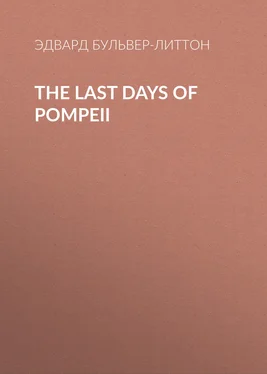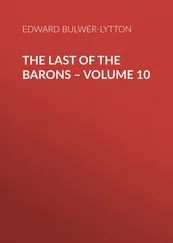Эдвард Бульвер-Литтон - The Last Days of Pompeii
Здесь есть возможность читать онлайн «Эдвард Бульвер-Литтон - The Last Days of Pompeii» — ознакомительный отрывок электронной книги совершенно бесплатно, а после прочтения отрывка купить полную версию. В некоторых случаях можно слушать аудио, скачать через торрент в формате fb2 и присутствует краткое содержание. Жанр: Альтернативная история, literature_19, foreign_antique, foreign_prose, Исторические приключения, на английском языке. Описание произведения, (предисловие) а так же отзывы посетителей доступны на портале библиотеки ЛибКат.
- Название:The Last Days of Pompeii
- Автор:
- Жанр:
- Год:неизвестен
- ISBN:нет данных
- Рейтинг книги:4 / 5. Голосов: 1
-
Избранное:Добавить в избранное
- Отзывы:
-
Ваша оценка:
- 80
- 1
- 2
- 3
- 4
- 5
The Last Days of Pompeii: краткое содержание, описание и аннотация
Предлагаем к чтению аннотацию, описание, краткое содержание или предисловие (зависит от того, что написал сам автор книги «The Last Days of Pompeii»). Если вы не нашли необходимую информацию о книге — напишите в комментариях, мы постараемся отыскать её.
The Last Days of Pompeii — читать онлайн ознакомительный отрывок
Ниже представлен текст книги, разбитый по страницам. Система сохранения места последней прочитанной страницы, позволяет с удобством читать онлайн бесплатно книгу «The Last Days of Pompeii», без необходимости каждый раз заново искать на чём Вы остановились. Поставьте закладку, и сможете в любой момент перейти на страницу, на которой закончили чтение.
Интервал:
Закладка:
In this hall (or atrium, to speak classically) the clients and visitors of inferior rank were usually received. In the houses of the more 'respectable', an atriensis, or slave peculiarly devoted to the service of the hall, was invariably retained, and his rank among his fellow-slaves was high and important. The reservoir in the centre must have been rather a dangerous ornament, but the centre of the hall was like the grass-plot of a college, and interdicted to the passers to and fro, who found ample space in the margin. Right opposite the entrance, at the other end of the hall, was an apartment (tablinum), in which the pavement was usually adorned with rich mosaics, and the walls covered with elaborate paintings. Here were usually kept the records of the family, or those of any public office that had been filled by the owner: on one side of this saloon, if we may so call it, was often a dining-room, or triclinium; on the other side, perhaps, what we should now term a cabinet of gems, containing whatever curiosities were deemed most rare and costly; and invariably a small passage for the slaves to cross to the further parts of the house, without passing the apartments thus mentioned. These rooms all opened on a square or oblong colonnade, technically termed peristyle. If the house was small, its boundary ceased with this colonnade; and in that case its centre, however diminutive, was ordinarily appropriated to the purpose of a garden, and adorned with vases of flowers, placed upon pedestals: while, under the colonnade, to the right and left, were doors admitting to bedrooms, to a second triclinium, or eating-room (for the ancients generally appropriated two rooms at least to that purpose, one for summer, and one for winter—or, perhaps, one for ordinary, the other for festive, occasions); and if the owner affected letters, a cabinet, dignified by the name of library—for a very small room was sufficient to contain the few rolls of papyrus which the ancients deemed a notable collection of books.
At the end of the peristyle was generally the kitchen. Supposing the house was large, it did not end with the peristyle, and the centre thereof was not in that case a garden, but might be, perhaps, adorned with a fountain, or basin for fish; and at its end, exactly opposite to the tablinum, was generally another eating-room, on either side of which were bedrooms, and, perhaps, a picture-saloon, or pinacotheca. These apartments communicated again with a square or oblong space, usually adorned on three sides with a colonnade like the peristyle, and very much resembling the peristyle, only usually longer. This was the proper viridarium, or garden, being commonly adorned with a fountain, or statues, and a profusion of gay flowers: at its extreme end was the gardener's house; on either side, beneath the colonnade, were sometimes, if the size of the family required it, additional rooms.
At Pompeii, a second or third story was rarely of importance, being built only above a small part of the house, and containing rooms for the slaves; differing in this respect from the more magnificent edifices of Rome, which generally contained the principal eating-room (or caenaculum) on the second floor. The apartments themselves were ordinarily of small size; for in those delightful climes they received any extraordinary number of visitors in the peristyle (or portico), the hall, or the garden; and even their banquet-rooms, however elaborately adorned and carefully selected in point of aspect, were of diminutive proportions; for the intellectual ancients, being fond of society, not of crowds, rarely feasted more than nine at a time, so that large dinner-rooms were not so necessary with them as with us. But the suite of rooms seen at once from the entrance, must have had a very imposing effect: you beheld at once the hall richly paved and painted—the tablinum—the graceful peristyle, and (if the house extended farther) the opposite banquet-room and the garden, which closed the view with some gushing fount or marble statue.
The reader will now have a tolerable notion of the Pompeian houses, which resembled in some respects the Grecian, but mostly the Roman fashion of domestic architecture. In almost every house there is some difference in detail from the rest, but the principal outline is the same in all. In all you find the hall, the tablinum, and the peristyle, communicating with each other; in all you find the walls richly painted; and all the evidence of a people fond of the refining elegancies of life. The purity of the taste of the Pompeians in decoration is, however, questionable: they were fond of the gaudiest colors, of fantastic designs; they often painted the lower half of their columns a bright red, leaving the rest uncolored; and where the garden was small, its wall was frequently tinted to deceive the eye as to its extent, imitating trees, birds, temples, etc., in perspective—a meretricious delusion which the graceful pedantry of Pliny himself adopted, with a complacent pride in its ingenuity.
But the house of Glaucus was at once one of the smallest, and yet one of the most adorned and finished of all the private mansions of Pompeii: it would be a model at this day for the house of 'a single man in Mayfair'—the envy and despair of the coelibian purchasers of buhl and marquetry.
You enter by a long and narrow vestibule, on the floor of which is the image of a dog in mosaic, with the well-known 'Cave canem'—or 'Beware the dog'. On either side is a chamber of some size; for the interior part of the house not being large enough to contain the two great divisions of private and public apartments, these two rooms were set apart for the reception of visitors who neither by rank nor familiarity were entitled to admission in the penetralia of the mansion.
Advancing up the vestibule you enter an atrium, that when first discovered was rich in paintings, which in point of expression would scarcely disgrace a Rafaele. You may see them now transplanted to the Neapolitan Museum: they are still the admiration of connoisseurs—they depict the parting of Achilles and Briseis. Who does not acknowledge the force, the vigour, the beauty, employed in delineating the forms and faces of Achilles and the immortal slave!
On one side the atrium, a small staircase admitted to the apartments for the slaves on the second floor; there also were two or three small bedrooms, the walls of which portrayed the rape of Europa, the battle of the Amazons, etc.
You now enter the tablinum, across which, at either end, hung rich draperies of Tyrian purple, half withdrawn. On the walls was depicted a poet reading his verses to his friends; and in the pavement was inserted a small and most exquisite mosaic, typical of the instructions given by the director of the stage to his comedians.
You passed through this saloon and entered the peristyle; and here (as I have said before was usually the case with the smaller houses of Pompeii) the mansion ended. From each of the seven columns that adorned this court hung festoons of garlands: the centre, supplying the place of a garden, bloomed with the rarest flowers placed in vases of white marble, that were supported on pedestals. At the left hand of this small garden was a diminutive fane, resembling one of those small chapels placed at the side of roads in Catholic countries, and dedicated to the Penates; before it stood a bronzed tripod: to the left of the colonnade were two small cubicula, or bedrooms; to the right was the triclinium, in which the guests were now assembled.
This room is usually termed by the antiquaries of Naples 'The Chamber of Leda'; and in the beautiful work of Sir William Gell, the reader will find an engraving from that most delicate and graceful painting of Leda presenting her newborn to her husband, from which the room derives its name. This charming apartment opened upon the fragrant garden. Round the table of citrean wood, highly polished and delicately wrought with silver arabesques, were placed the three couches, which were yet more common at Pompeii than the semicircular seat that had grown lately into fashion at Rome: and on these couches of bronze, studded with richer metals, were laid thick quiltings covered with elaborate broidery, and yielding luxuriously to the pressure.
Читать дальшеИнтервал:
Закладка:
Похожие книги на «The Last Days of Pompeii»
Представляем Вашему вниманию похожие книги на «The Last Days of Pompeii» списком для выбора. Мы отобрали схожую по названию и смыслу литературу в надежде предоставить читателям больше вариантов отыскать новые, интересные, ещё непрочитанные произведения.
Обсуждение, отзывы о книге «The Last Days of Pompeii» и просто собственные мнения читателей. Оставьте ваши комментарии, напишите, что Вы думаете о произведении, его смысле или главных героях. Укажите что конкретно понравилось, а что нет, и почему Вы так считаете.












